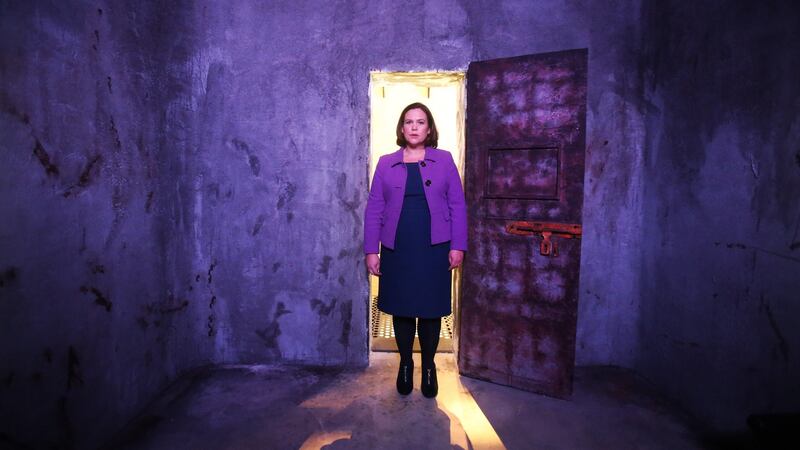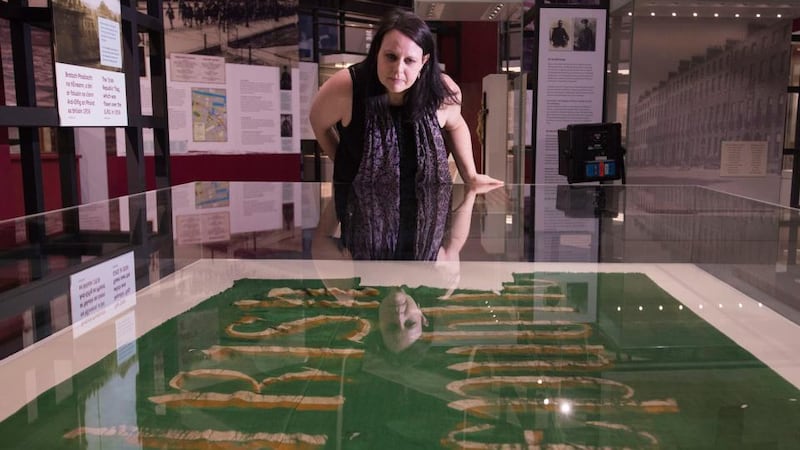In the newly refurbished interior of the GPO a wall bears the names of all those known to have helped defend the building during Easter Week 1916. The list runs to more than 400 people, and there's space for additions should further information be unearthed.
We’re encouraged to search for ancestors or relatives. I peer at the long list, but I already know what I’m going to find. Nope. Nothing. Nobody. Not a sausage. And none in Bolands or Jacob’s or anywhere else.
Being a small nation, we’re used to being able to hang a personal connection pretty quickly on most of the major events in our history. But a lack of any personal connection to the Rising is probably more the norm than is commonly admitted. After all, the insurrection was the work of a small splinter of a minority of one faction in a long-vanished political landscape.


At this moment, though, and for the next 10 days, the Easter Rising is demanding more of our attention than it has done for many years, and possibly more than it ever will again. In the past week alone I’ve heard Patrick Pearse’s words being performed by at least five different actors. The Proclamation has been read in schools across the country. Documentaries, dramas and supplements are being broadcast and published daily. It’s hard to tell what impact or effect any of this has, or if it has any at all.
One of the defining features of a centenary, besides its representing a satisfyingly round, if rather arbitrary number, is that it marks the final point at which an event passes completely out of living memory. With that passing, related personal sensitivities and political animosities sometimes ease or even disappear. It is also a moment when the historical narrative can be re-examined and seen with fresh eyes. Possibly.
The reality is more complex. The Rising, as the founding myth of the State, carries all the burdens that come along with that. Historians can explore new readings or perspectives, and some of those will make their way into the mainstream. But flags must be waved, and banners unfurled, and there’s not much room for nuance when it comes to a slogan on the side of a bus.
Straddling the divide between historical inquiry and public spectacle are the exhibitions and installations that seek to make the Rising meaningful and explicable both to Irish people and to international visitors. Three of these lie within a 20-minute walk of each other along the east-west axis of Dublin’s north inner city.
It’s the same streetscape that saw the Rising’s most intense and prolonged fighting, and in its current mix of vibrancy and dereliction, commerce and poverty, it offers a pretty accurate snapshot of the state of the nation in 2016.
Collins Barracks
Starting in the west, Proclaiming a Republic: The 1916 Rising, at the National Museum of Ireland's Collins Barracks branch, is surprisingly busy when I arrive on a grey Tuesday afternoon. The visitors seem to be split evenly between locals and tourists.
The exhibition has, as you would expect of the National Museum, the most comprehensive collection of artefacts, everything from weapons to uniforms, handwritten messages to first-aid supplies. The most evocative exhibits are the flags, including the Starry Plough that flew over the Imperial Hotel and the green flag, with the words “Irish Republic”, that was raised over the GPO.
PCs are available for visitors to explore in more detail, but space is a little cramped, some elements are too text heavy and the dull lighting does none of the displays any great favour.
Weaponry and military regalia are reverently displayed like religious relics in glass cases. The guns – most of them near-obsolete even at the time – do offer some heightened sense of tangible connection to the real violence of the particular moment.
Other attempts to provide context are less successful: a single Orange sash hardly conveys the political divisions of the day.
The Ambassador
Arms feature even more prominently in Revolution 1916, at the Ambassador Theatre, on Parnell Square. The rattle of machine guns and the boom of shellfire provide the audio backdrop for the exhibition, which takes a decidedly less nuanced or historically objective view of 1916.
There’s no acknowledgment in the About Us section of its website that this project is associated with Sinn Féin, although the party is credited at the bottom of the page. It’s also not cheap for what you get.
Again, there is too much text on boards, along with a smaller selection of military paraphernalia, and “artistic” representations of Irish history down the centuries, which support the narrative (contained in the Proclamation) that the Rising was part of a centuries-long political struggle for freedom, one that is still ongoing.
If you’ve missed the point, the final element takes an unexpected and unexplained leap 60 years forward to the republican hunger strikes of the 1970s and 1980s, which are depicted in such a banal and propagandistic way as to undermine anything that has gone before.
The GPO
The GPO's Witness History, which doesn't open to the public until March 29th, is in a different league in its technical sophistication, storytelling and staging.
To be fair, this is on a different scale. A permanent interpretive centre in receipt of several million euro from the State, in association with An Post, it finally redresses the glaring absence of an appropriate memorial to the Rising at its central location.
It’s all very impressive. Touch-screen panels allow you to explore strands of the narrative through interactive graphics, which bring home, for example, how civilian casualties escalated over the course of the week. There’s a much better sense of the city as a whole, and how the Rising affected it. And the refurbishment of the building and its inner courtyard allows Dubliners for the first time into the mysterious innards of the GPO proper.
Historians looking back in 20 or 50 years will probably note these 2016 commemorations as the time when the role of women in the Rising was finally acknowledged. This is a common thread across the Collins Barracks, Ambassador Theatre and GPO exhibitions.
But there are striking absences, too. There’s very little on the international context, although the revolutionary nationalism of the 1916 leaders was part of a wider movement for the independence of small nations across Europe against the backdrop of the war.
The fact that the Rising was an inspiration for anti-colonial movements across the world gets short shrift.
Easter 1916 was a point of violent rupture between an old world and a new one; walking the streets of Dublin this week, or staring out of the windows of the GPO as the city goes about its business, one can’t help wondering what that small and unrepresentative band of rebels would have thought of the world they helped to create.
History in the making: when each exhibition is open, what it costs and what it offers
Proclaiming a Republic: the 1916 Rising
National Museum of Ireland: Decorative Arts and History, Collins Barracks, Dublin 7. Tuesday to Saturday, 10am-5pm; Sunday 2-5pm; closed Mondays, including bank holidays. Entry free; museum.ie
Entry is free, so it wins hands down on price. As you would expect, it also has the most significant artefacts: armaments, uniforms and the flags that flew over O’Connell Street during Easter Week. For the broadest educational overview of the Rising in all its facets and contexts, this is also the best offering.
The presentation and staging of the exhibition are a bit dull, and the lighting leaves something to be desired. The museum recommends visiting on weekday afternoons and to avoid school holidays. Visitors may be asked to wait a short time before they can enter the exhibition.
Revolution 1916
Ambassador Theatre, Parnell Square, Dublin 1. Daily, 10am-6pm. Tickets €15 at door or €18 through ticketmaster.ie; child, family and group discounts available; revolution1916.ie
At times a bit homespun, this exhibition is well staffed, with friendly guides to offer directions. The Ambassador itself is sadly down at heel, which needn’t affect the quality of the exhibition. But, unfortunately, that quality isn’t great anyway: text-heavy boards describing key people and events; a perfunctory video; artefacts that aren’t as wide ranging or resonant as those at Collins Barracks; and a “re-creation” of cells and the yard at Kilmainham.
Things get more random with the inclusion of a car used to drive Michael Collins in the aftermath of the Treaty. The final exhibit, commemorating republicans who died on hunger strike in the 1980s, is part nonsequitur, part hagiography.
GPO: Witness History
(Opens March 29th). GPO, O'Connell Street, Dublin 1. Daily, 9am-5.30pm. Tickets €10 adults, €5 children; family tickets from €25. Other discounts available. Booking advised; gpowitnesshistory.ie
Unlike the other shows, this is a permanent installation – and one of the most significant State investments of this centenary year. A substantial part of the historic building has been opened to public access for the first time, which is interesting enough in itself.
The interactive elements and historic artefacts are well woven together and, for visitors unfamiliar with Irish history, this offers the clearest narrative of the context of the Rising. As the title suggests, it’s told through the eyes of witnesses to the events, from all sides and none. An impressive audiovisual presentation mixes CGI and dramatisation impressively to tell the story of the rebellion.









